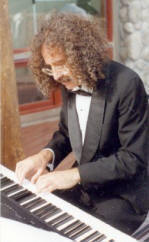Music
Maurice Ravel (or is it!?)
Instrumentation
Piano solo
The Girl With the Black Satin Smile, transcribed by Don "Orfeo" Rechtman (1980, updated 2020)
is licensed under the Creative Commons Attribution-NoDerivs 3.0 Unported License.
 (This means you can perform it non-commercially or commercially without having to pay royalties, but you are required to acknowledge its authorship and where you got it. You cannot modify it without written permission from Don "Orfeo" Rechtman.)
(This means you can perform it non-commercially or commercially without having to pay royalties, but you are required to acknowledge its authorship and where you got it. You cannot modify it without written permission from Don "Orfeo" Rechtman.)
Sheet Music
(To copy the score to your computer, right-click the link and select "Save target as... ".)
Piano Score PDF format
Piano Score SIB (Sibelius) format
Orchestra Score SIB (Sibelius) format
Recording
N/A. If you would like to make an audio or video recording, feel free to do so, and if you'd like, I'll post it here for you!
Video
(To copy the score to your computer, right-click the link and select "Save target as... ".)
This is a Sibelius-generated rendition of the music piano score.
This is a Sibelius-generated rendition of the music orchestra score.
Practice Tracks
N/A
Lyrics Printout
N/A
Notes
The Girl With the Black Satin Smile
La fille au sourire de satin noir
Music of Maurice Ravel, as transcribed by Don Orfeo
During my brief tenure at the Peabody Conservatory of Music, I took the unauthorized liberty of exploring their library archives.
One of several items that grabbed my interest was a short piano piece by Ravel. Still in recovery from having an amoral nature,
I nonetheless decided to make a handwritten copy of the music rather than pilfering it outright.
When I recently was exploring my own archives, I rediscovered my copy, and with a bit of research ascertained that the piece
was as yet unknown to the public, and was apparently not published in his lifetime. When I contacted Peabody, they could not find
the document I had seen nor had any record of its existence, so up till now at least, I was apparently the only one cognizant of
the work’s existence. I decided this needed to change, and have therefore typeset the music based upon my handwritten copy.
While undated, my best guess is it was written around 1909, about the time Ravel was orchestrating his “Pavane for a Dead
Princess,” which was also shortly before Debussy wrote his “Girl With the Flaxen Hair.” Both of these compositions bear great
resemblance to the Satin Smile work, and it may even be suggested that, though Debussy was ten years the elder, both the
title and the music of Ravel’s Satin Smile may have been part of the inspiration for Debussy’s Flaxen hair.
The most uncharacteristic aspect of Ravel’s writing style in this piece is his overabundance of pedal markings. It is also of
interest of his notation to pluck the strings inside the piano for the first two bass notes, which gives the opening an ethereal
aspect so characteristic of his Pavane and especially of his later works. Because the strings should be identified and labeled
prior to the performance, this also marks his Satin Smile as one of the earliest pieces written for prepared piano!
Don Orfeo
2 July 2020
